Key Takeaways:
- Cryptocurrency prices recovered slightly on Apr 21. Bitcoin prices jumped above $42,000 after a week but failed to hold the level.

NEW DELHI (CoinChapter.com) — The cryptocurrency market recovered slightly on Apr 21 as most cryptos continue to move laterally. The overall crypto market cap fell to $1.91 trillion, a decline of 0.68% in 24 hours, as per CoinMarketCap data.
Bitcoin rose above $42,000, riding on macro cues as the U.S. dollar currency index (DXY) fell sharply after reaching 101 on Apr 20. However, BTC couldn’t maintain its uptrend, likely due to its strong correlation with the S&P 500.
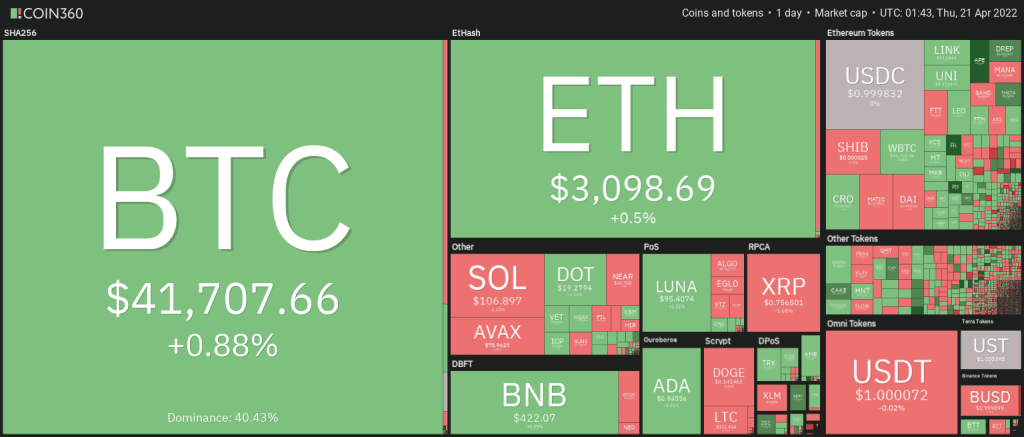
However, positive cues remain, such as a report by Insider Intelligence that predicts the number of adults in the United States who will use crypto to make purchases in 2022 will increase to 3.6 million. In addition, Australian financial regulators approved the country’s first Bitcoin Exchange Traded Fund (ETF).
The ETF will begin trading on Apr 27 and is expected to generate $1 billion in inflows.
BTC/USD
Bitcoin price moved above Apr 20 for the first time since Apr 11 but failed to hold above the price level. However, the token reversed its downside movement after reaching near $38,600 on Apr 18. A long lower wick on the day’s candle indicates aggressive buying by bulls at lower price levels.
However, Bitcoin’s 20-day Moving average (red wave) seems poised to move below its 50-day MA (yellow wave) to form a bearish technical pattern called a death cross. Traders believe the technical pattern signals negative sentiment and weakness.
If traders start a sell-off, BTC prices could fall below the 100-day MA (purple wave) to support near $41,000. Further downtrend could see Bitcoin test support near $39,000, a price level that has supported BTC price action since Apr 11.
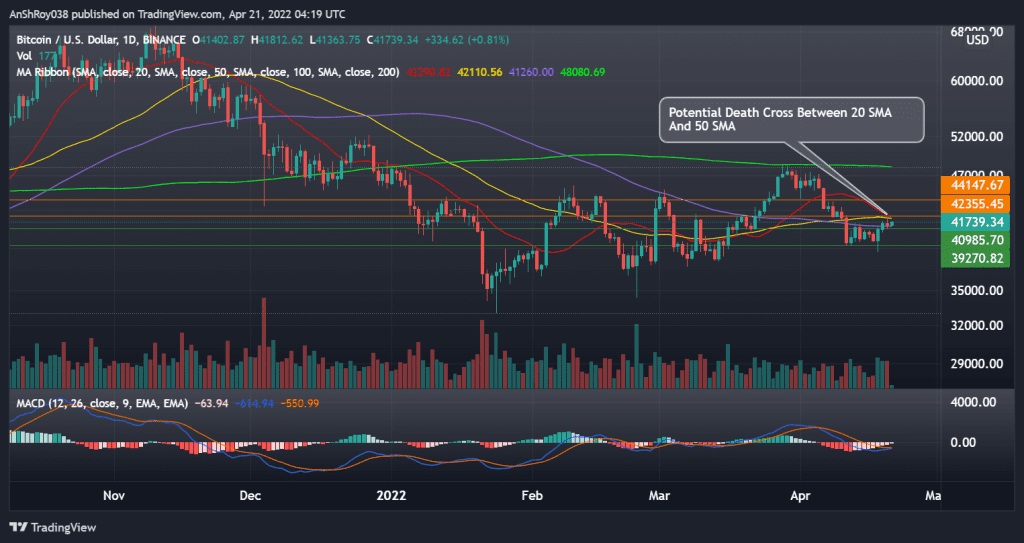
Conversely, if BTC avoids the death cross induced sell-off, the token would need to flip 20-day MA (red wave) and 50-day MA (yellow wave) resistance confluence near $42,300. A move above immediate resistance could increase traders’ confidence in its bull run.
Bitcoin would next target resistance near $44,000, a price level that rebuffed the token’s uptrend several times between Jan 5 and Mar 25 this year.
Related: Bitcoin leaving exchanges hit its lowest number since August 2018 as BTC eyes $50K-retest.
Meanwhile, momentum oscillator MACD continues to be bearish for Bitcoin. However, bars on the MACD histogram, which charts the difference between the MACD line (difference between 12-day and 26-day EMA) and the MACD signal line (9-day EMA of MACD), are contracting.
Contracting negative bars indicate increasing bullishness in BTC’s price momentum.
At the time of writing, BTC was trading at $41,589, up 0.41% on the day.
ETH/USD
Bears tried to push Ether (ETH) prices below the Ethereum token’s 50-day MA (yellow wave) on Apr 18. However, bulls bought the dip to push ETH above the 50-day MA. At present, ETH faces resistance from its 20-day MA (red wave) near $3,140, which has resisted ETH uptrends since Apr 11.
If the Ethereum token flips immediate support, ETH might move to target resistance near $3,260. Moreover, ETH could take bullish cues from its MACD.
Although momentum oscillator MACD continues to be bearish for Ether, bars on the MACD histogram, which charts the difference between the MACD line (difference between 12-day and 26-day EMA) and the MACD signal line (9-day EMA of MACD), are contracting.
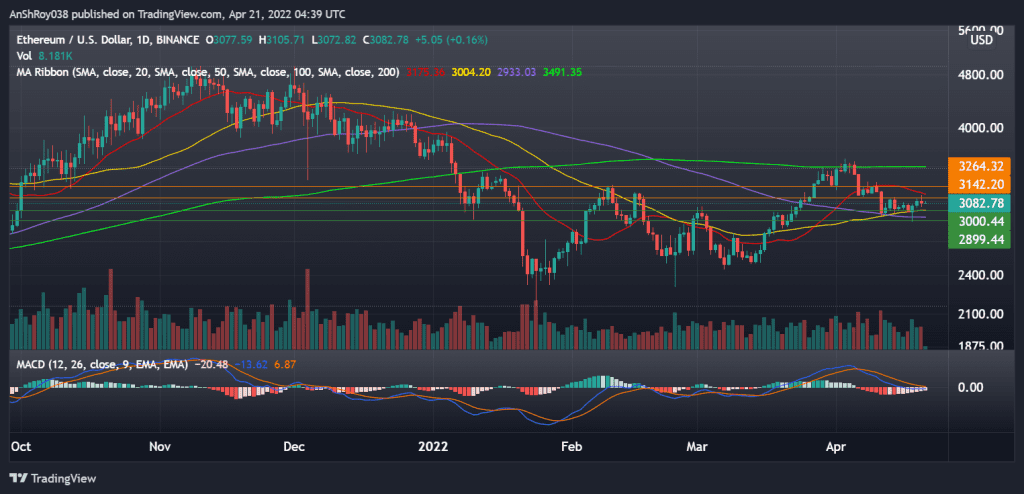
Contracting negative bars indicate increasing bullishness in ETH price momentum.
On the other hand, if bulls fail to start an uptrend, Ether could test support from its 50-day MA (yellow wave) near $3,000. Further sell-off could push ETH’s price below its 100-day MA (purple wave) to support near $2,900.
At the time of writing, ETH was trading at $3,081, up 0.12% on the day.
DOGE/USD
Dogecoin has struggled to move above its 20-day MA (red wave) after falling below it on Apr 11. Bears tried to push DOGE price below its 50-day MA (yellow wave) on Apr 18. However, the long lower wick on the day’s candle indicates bulls aggressively defended the level.
Immediate resistance for DOGE is near its 20-day MA (red wave) at $0.145. However, a continued uptrend could see the Dogecoin token challenge resistance near $0.15, a price level that has rejected DOGE’s uptrend several times since Feb 11 this year.
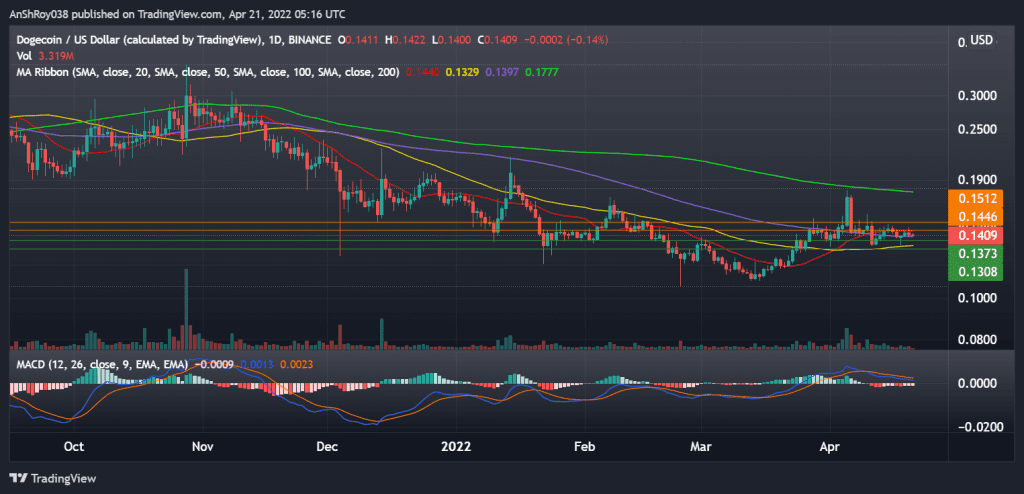
Conversely, if the meme token fails to register an uptrend, DOGE could fall below its 100-day MA (purple wave), acting as dynamic support for the Dogecoin token since Apr 3, to test support near $0.137.
A marketwide sell-off could see DOGE fall to support near its 50-day MA (yellow wave) near $0.13, a price level that previously acted as supported between Jan 22 and Feb 23.
Also Read: Dogecoin rallies as Elon Musk joins Twitter board of directors.
Meanwhile, momentum oscillator MACD continues to be bearish for Dogecoin. However, bars on the MACD histogram, which charts the difference between the MACD line (difference between 12-day and 26-day EMA) and the MACD signal line (9-day EMA of MACD), seem to be contracting.
Contracting negative bars indicate the MACD line is moving towards its signal line and might chart a bullish crossover soon.
At the time of writing, DOGE was trading at $0.139, down 1.35% on the day
XLM/USD
Stellar (XLM) prices moved above the token’s 50-day MA (yellow wave) on Apr 18 but failed to hold above it. The Stellar Lumens token fell below the 50-day MA on Apr 20, with the downside likely resulting from a death cross between the 20-day MA (red wave) and the 100-day MA (purple wave).
In detail, a death cross forms when a token’s short-term moving average trendline (20-day MA in this case) moves below a relative long-term moving average (100-day MA for XLM). Traders believe the technical pattern signals negative sentiment and weakness.
If the downtrend continues, XLM price could fall to immediate support near $0.197, a price level that previously acted as resistance for the Stellar token between Feb 20 and Mar 19 this year. A sustained sell-off could see XLM test $0.187, which previously supported XLM price action between Jan 22 and Feb 3.
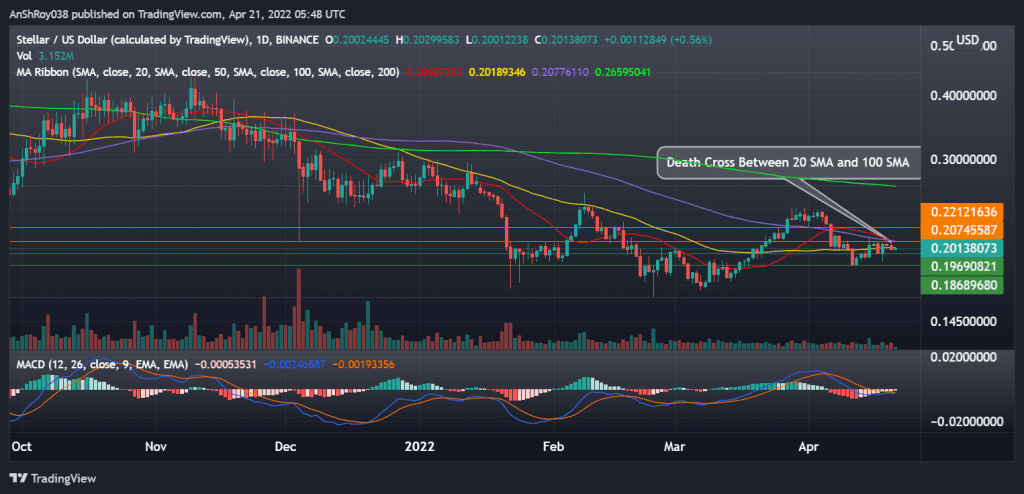
However, XLM could take bullish cues from its MACD. The MACD histogram, which charts the difference between the MACD line (difference between 12-day and 26-day EMA) and the MACD signal line (9-day EMA of MACD), is painting contracting bearish bars on the daily charts.
Contracting bearish bars indicate the MACD line is moving towards its signal line and might chart a bullish crossover soon, providing bullish cues for the Stellar token.
XLM needs to flip the 20-day MA (red wave) and 100-day MA (purple wave) resistance confluence near $0.207. A move above immediate resistance would help increase investor confidence in the Stellar token’s price action.
Afterward, XLM might challenge resistance near $0.22, a price level that acted as a resistance between Feb 11 and Mar 27.
At the time of writing, XLM was trading at $0.201, up 0.45% on the day.
AVAX/USD
AVAX prices tested a nearly three-month-long ascending trendline support on Apr 18. Strong buying pressure from the bulls helped the Avalanche token recover and close above the support.
However, AVAX’s 20-day moving average (red wave) moved below its 200-day MA (green wave) to form a death cross. The pattern forms when a token’s short-term moving average trendline moves below a relative long-term moving average.
Traders often consider the technical pattern signals negative market sentiment and weakness. As a result, AVAX prices fell 2.6% on Wednesday. The Avalanche token seems to be in the grip of the bears in the early hours of trading on Apr 21.
AVAX could test support from the ascending trendline near $76. A marketwide sell-off could see the Avalanche token price fall to support near $70, a price level that has successfully supported AVAX price action multiple times between Feb 4 and Mar 16.
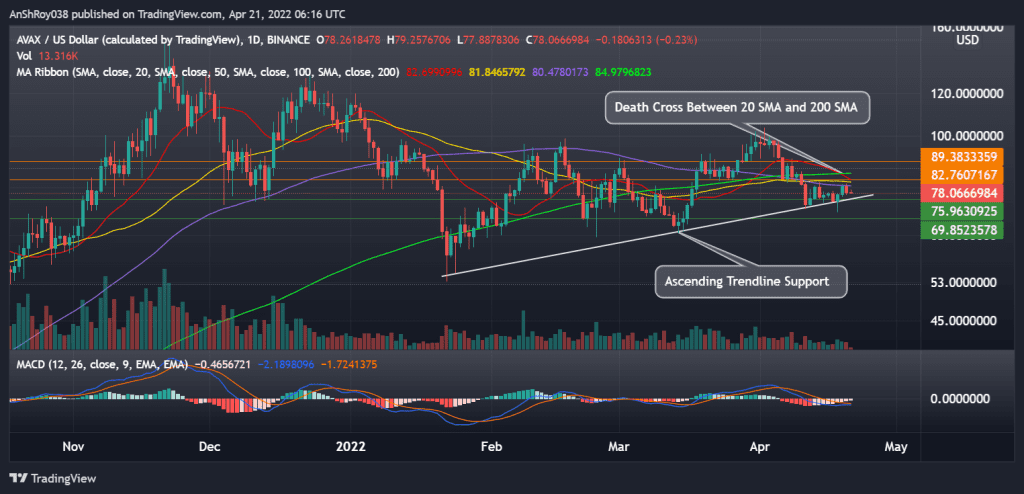
Conversely, if AVAX breaks above 20-day MA (red wave) and 50-day MA (yellow wave) resistance confluence near $83, the Avalanche token might move to challenge $89.4.
$89.4 previously acted as resistance for the Avalance token between Feb 9 and Mar 28. Meanwhile, momentum oscillator MACD continues to be bearish for the Avalanche token.
Also Read: Avalanche’s incredible network growth does little in limiting AVAX price’s 40% crash risks.
However, the MACD histogram, which charts the difference between the MACD line (difference between 12-day and 26-day EMA) and the MACD signal line (9-day EMA of MACD), is painting bearish contracting bars on the daily charts.
Contracting negative bars indicate the MACD line is moving towards its signal line and might chart a bullish crossover soon.
At the time of writing, AVAX was trading at $78.32, up 0.09% on the day.
SOL/USD
Solana token prices bounced off the ascending channel support on Apr 18 to move back above SOL’s 50-day MA (yellow wave). Monday’s daily candle’s long lower wick indicates bulls are aggressively buying the dip.
SOL failed to move above its 20-day moving average (red wave) resistance near $111, indicating bears are profit booking on relief rallies. If SOL flips immediate resistance, the token would likely move to challenge resistance near $120, which previously acted as a resistance between Feb 19 and Mar 30.
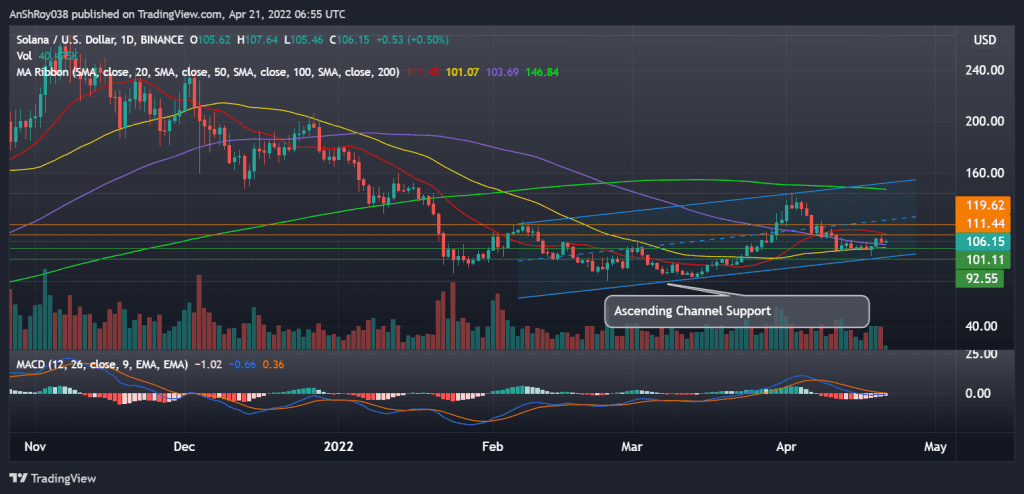
Conversely, if the Solana token prices fall from current levels, SOL could fall to support from its 50-day MA (yellow wave) near $101. Moreover, a marketwide sell-off could see the crypto test support near $92, a price level that previously acted as support between Jan 22 and Feb 17 earlier this year.
Momentum oscillator MACD is forecasting bullish signals for the Solana token.
Also Read: Solana (SOL) might be headed for a 112% hike — analyst asserts
Although the indicator is currently bearish for SOL, the MACD histogram, which charts the difference between the MACD line (difference between 12-day and 26-day EMA) and the MACD signal line (9-day EMA of MACD), is painting contracting bearish bars on the daily charts.
Contracting bearish bars indicate the MACD line is moving towards its signal line and might chart a bullish crossover soon, providing bullish cues for the Solana token.
At the time of writing, SOL was trading at $106, up 0.49% on the day.


